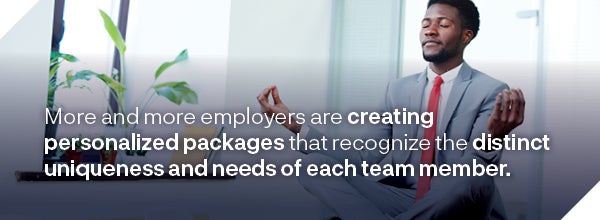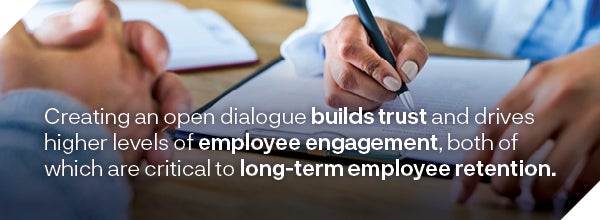Once upon a time, most businesses could rely on wages and salaries to attract talented employees. Securing the services of strong candidates was often purely a question of money. But much of that has since changed—and quickly—in the post-COVID-19 hiring and retention landscape. For many job-seekers, money is no longer enough. As a result, some businesses needed to prioritize their benefits package to attract top talent.
Multiple trends can be seen driving the shift in attention toward employee benefits. Inflation rates hit multi-decade highs in the early 2020s, prompting some job-seekers to demand more from their employers. At the same time, cash-strapped businesses have had to grapple with their own financial limitations.
But with a creative benefits package for employees, businesses can work to build their appeal to candidates while also controlling their spending on wages and salaries. When all other elements are equal in competitive hiring situations, candidates often choose the offer with the best and most complete supplementary benefits.
With these strategic elements in mind, the time may be right for businesses to reevaluate their employee benefits and HR packages. This article explores the shifting benefits landscape and looks at proven ways you may be able to leverage benefits to attract and retain quality employees.

How HR Benefits Packages for Employees Have Evolved Over Time
Leaders have long recognized the importance of offering supplementary benefits that go beyond base pay. In 1875, American Express became the first US company to launch an internal pension plan for its employees. With the rise of organized labor in the early 20th century, healthcare benefits and retirement packages became increasingly common in industrialized countries around the world.
The way companies configure their benefits packages for employees has also changed over time. Company sponsored defined benefits plans, which use formulas based on factors such as salary and service time to generate reliable fixed income for pensioners, were once the norm. Now, they’ve largely given way to employer funded defined contribution plans based on using 401K accounts and IRAs as retirement savings vehicles.
Generational Values and Their Impacts on Employee Benefits
Divergent generational values are another catalyst for ongoing changes to benefits structures. Salary, healthcare benefits, and retirement benefits were generally important to the baby boomer generation. Meanwhile, Generation X often prioritized work-life balance, advancement potential, job security, and defined contribution programs.
Younger generations, including millennials and Generation Z, have been seen to put further pressure on employers to change their benefits package for employees. These workers tend to favor personalized benefits, paid time off, flexible scheduling, remote working opportunities, and digital health benefits.
Some employers have responded to shifting labor market trends by introducing novel elements to their employee benefits programs. Examples of new benefits may include:
- Comprehensive wellness programs that consider both physical and mental health
- Flexible on-site attendance policies that prioritize both hybrid and remote work and promote a better work-life balance
- Transportation benefits designed to address the many pain points associated with daily commuting
- Tuition reimbursement programs
- Emergency Savings programs
- Student loan repayment assistance programs
When factored in alongside traditional healthcare and retirement benefits, these elements can help create complete packages that address the values and needs of diverse employee demographic groups.

Build a Better Benefits Package for Employees: Expert Recommendations
To create a compelling benefits package for employees, it may no longer be enough to simply offer generic healthcare and retirement perks. Instead, businesses might want to consider a dynamic set of interrelated factors that recognize the “human” aspects of human resources.
Individualization has also become important. More and more employers are creating personalized packages that recognize the distinct uniqueness and needs of each team member.
To these ends, the following strategic best practices can help you build a better benefits package for employees while staying mindful of your financial realities:
Conduct a Benefits Survey and Analysis
Employee benefits surveys provide a way to obtain honest feedback from current members of your team. Anonymity tools prompt higher levels of participant honesty, so businesses can make reliable assessments of where and how their current benefits programs succeed and fail.
Experts recommend asking targeted questions that allow for detailed responses. Some questions that can help orient your benefits program may be:
- Do you find it easy or difficult to access your current benefits?
- Are you satisfied with your benefits package? Why or why not?
- Which of your current benefits do you consider the most important?
- Did our benefits package for employees influence your decision to work here?
- How well does your current benefits package meet your needs (on a scale of 0–5 or 0–10)?
You can also ask similar questions with reference to specific elements of your benefits package, such as matching retirement contributions, stock options, health and wellness, transportation, professional development, parental leave, and so on. When analyzing responses, look for clear trends that indicate specific strengths and shortcomings.

The more data you collect, the more reliable your results can be. To encourage participation, businesses might offer a modest but enticing reward to employees who submit a completed survey.
Experts also recommend engaging team members in efforts to improve your employee benefits. Creating an open dialogue builds trust and drives higher levels of employee engagement, both of which are critical to long-term employee retention.
Align Your Benefits With Your Business Goals and Values
Businesses can also drive engagement among employees and advance core business objectives by aligning organizational goals with their benefits package. This might involve using benefits programs to express and advance the organization’s underlying philosophy. Aligning a business’ goals with its benefits programs can help build positive internal cultures that foster stronger long-term relationships with employees.
To do this, first, identify the business goals you might want to achieve through your benefits program. For instance:
- Foster a diverse and inclusive work environment
- Provide employees with a positive place to learn, grow, and advance
- Promote a healthy and positive work-life balance
- Improve corporate social responsibility through mindful community citizenship
From there, you can design and develop a benefits package for employees that specifically advances the objective you identified. To this end, some experts recommend a simple, five-step approach:
- Ensure your goals, mission, and company values are up to date and reflect the organization’s current perspective.
- Give all employees a voice by collecting feedback on both your organizational mission and the benefits you offer.
- Implement environmental, social, and corporate governance (ESG) values into your benefits program. ESG-oriented benefits increasingly resonate with younger workforce demographics.
- Ensure your benefits program prioritizes inclusion and diversity. Make benefits scalable, flexible, and easily accessible through self-service online channels.
- Eliminate benefits that conflict with organizational values and goals or otherwise fail to advance them.
Balance the Cost and Value of Your Benefits
In designing a benefits package, businesses should consider balancing financial realities with their desire to impress employees and take better care of their health and well-being. As such, businesses need to be strategic to control costs while maximizing the appeal and impact of their employee benefits programs.
Let’s look at some key considerations in this regard.
Mandatory vs. Voluntary Benefits
Major examples of mandatory benefits include:
- Workers’ compensation insurance
- Unemployment insurance
- Paid sick leave (in some jurisdictions)
Employers are required to provide mandatory benefits. As such, voluntary benefits—the benefits companies choose to offer—represent the only way for an employer to differentiate its benefit-based employee compensation from competitors.
In addition to a broad diversity of benefits, effective voluntary programs can include customization options. Some experts recommend “cafeteria style” programs, which let employees select a set number of specific benefits from a larger pool of available options. This can manage costs while giving employees more control over their benefits package.
Data analytics can also keep costs in check. Specialized tech tools can generate statistical insights into the cost-value propositions that specific benefits offer. They can help you determine which benefits to maintain, which to enhance, and which to discontinue.

Negotiating Favorable Terms With Providers and Vendors
Many types of benefits involve third-party vendors and providers, who partner with companies to manage and administer benefits. Major examples might include healthcare coverage, disability insurance, retirement plan administration and life insurance.
Businesses can sometimes secure savings by negotiating with these third-party providers. Key points to consider leveraging in negotiations include size and scalability. Large businesses and businesses with strong growth potential have added appeal, which can make third-party vendors more likely to offer a price break.
Taking Advantage of Subsidies and Tax Incentives
Government subsidies and tax-based incentives can also help businesses reduce and control their out-of-pocket spending on benefits. You may be able to maximize these advantages by building a benefits package for employees that prioritizes advantaged offerings.
These often include:
- 401K and IRA retirement savings accounts
- Flexible spending accounts (FSAs)
- Health savings accounts (HSAs)
- Transportation and commuter benefits
Notably, businesses may qualify for valuable tax credits when they establish new retirement plans for their employees. These credits can help offset the costs of launching and administering the program, which makes offering retirement benefits to employees a more readily attainable reality.
Communicate and Educate Your Employees About Your Benefits
Communication and employee education are important aspects of benefits administration. You can build the most incredible benefits package for employees of any company in your industry, but your efforts could still fail to generate meaningful returns if your employees don’t know about the benefits available to them.
Consider deploying the following strategies to help employees understand their benefits and how to use them:
- Include complete information on your employee benefits when you onboard new hires
- Engage middle managers in the benefits education process so they can answer essential questions posed by team members
- Create a dedicated, user-friendly portal for employees to explore, access, and manage all the benefits available to them
- Communicate frequently and proactively, and favor in-person channels when explaining benefits to employees
- Supplement with digital, multimedia, and print-based communications to reinforce messaging regarding the availability of benefits
As you use these strategies, monitor their results. Do they prompt employees to make better use of their benefits programs? Do you notice an uptick in the rates at which employees access their benefits in the immediate aftermath of an awareness push?

If your communication efforts aren’t generating the desired results, consider further diversifying the channels and media you use to relay them. You can also consider holding a voluntary seminar on benefits education and offer an incentive or reward to employees who choose to participate.
Enhancing Employee Retirement Benefits: How Retirement Plan Services Can Help
For businesses that want to build a better retirement benefits package for employees, partnering with the right retirement advisor can often make a world of difference. It’s important to look for an advisor that focuses on your business first and creates a plan that’s perfect for your company culture.
The Retirement Plan Services (RPS) Team of experts can help you minimize your fiduciary liability by offering investment oversight, employee education and comprehensive retirement plan solutions such as:
- §3(38) Investment Fiduciary Services: Careful investment option selection and monitoring is critical to helping your plan participants reach their retirement goals.
- Due Diligence Support for Fiduciaries: Regardless of how much you delegate your plan’s investment oversight and administration, plan sponsors always play a central role as Plan Fiduciary. Advisors can help you understand and execute the key aspects of your fiduciary responsibilities, so you feel confident in your decisions.
- Employee Education and Financial Wellness: At the heart of every employee benefits plan are clear and effective communications that lead to greater participation. These programs support employees’ overall financial success, which leads to a happier and more productive workforce.
- Investment Options that are equipped with an open architecture approach, fee transparency, a disciplined fiduciary process for fund selection, and more.
- Plan Design Consultation: Plan design is not a one-size-fits-all proposition and best practices continually evolve due to changes in the regulatory landscape and advancements in technology. Our team of experts can help ensure that your plan fits the needs of your employees.
Partnering with an RPS retirement expert is especially critical in an evolving regulatory landscape defined by market volatility, uncertainty, inflation, and rising administrative costs.
Craft Your Employee Benefits Package With a Retirement Plan Services Professional
The business banking professionals at Bank of Blue Valley, a division of HTLF Bank have helped enterprises of all sizes meet their financing needs. If you want to create a better benefits package for your employees, we can help you find the strategic, logistical, and financing tools you need to differentiate your company in the challenging current labor market.
Bank of Blue Valley, a division of HTLF Bank directly supports multiple benefits-related financial services, including treasury and payment solutions for commercial clients and retirement benefits planning services. Reach out to Bank of Blue Valley, a division of HTLF Bank to arrange a personalized session with one of our commercial bankers today.
Products offered through Heartland Retirement Services are not FDIC insured and are not bank-guaranteed and may loose value.
These links are being provided as a convenience and for informational purposes only; they do not constitute an endorsement or an approval by HTLF of any of the products, services or opinions of the corporation or organization or individual. HTLF bears no responsibility for the accuracy, legality or content of the external site or for that of the subsequent links. Contact the external site for answers to questions regarding its content and privacy rules.









